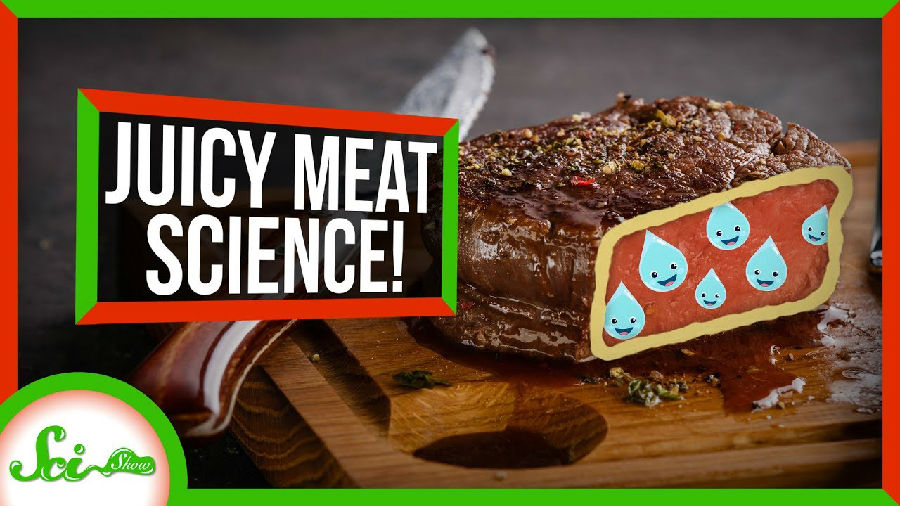Thanks to Skillshare for supporting this episode of SciShow.
感谢Skillshare对本期《科学秀》的支持。
Cookbooks, TV chefs, home cooks - we've all heard somewhere
食谱、电视大厨、家里的掌勺 — 我们都听说过
that we should sear meat before we cook it to "lock in the juices."
烤肉才能“锁住肉汁。”
Funnily enough, that reasoning is completely wrong, but you should still sear your steaks!
有趣的是,虽然这种说法是完全错误地,但你还是应该把牛排烤着吃!
This misconception has been around for a really long time.
这种误解已经存在很长时间了。
This idea might have gotten some traction in the 1840s thanks to Justus von Liebig,
这种想法可追溯到19世纪40年代,多亏了尤斯图斯·冯·李比希,
a German chemist who wrote about the benefits of searing meat in his book Researches on the Chemistry of Food.
这位德国化学家在他的书《Researches on the Chemistry of Food》中提到了烤肉的好处。
And we've actually known this to be untrue for a while.
其实我们早就知道这不是真的。
For example, it was debunked in research published back in 1974.
例如,1974年发表的一项研究就揭穿了这一点。
The results of that study showed that searing actually causes meat to lose more moisture, not less.
该研究结果表明烤肉实际上会使肉流失更多水分。
In a sample of 12 seared cuts of meat and 12 unseared control samples,
在12块烤肉和12块未烤过对照样本中,
the ones that got a blast of heat first lost slightly more moisture - around 3%.
那些首先烤过的肉流失的水分更多—约3%。
Similar experiments have been conducted over the years, in the lab and in the kitchen, with similar results.
多年来也在实验室和厨房进行过类似的实验,得出的结果相似。
Some experiments have shown no difference in moisture loss,
一些实验表明水分流失并没差别,
while in others, non-seared steaks stayed a bit more moist. Either way, there's not a huge difference in searing first vs not.
而在其他实验中,没被烤过的牛排留住了更多水分。不管怎样,有没有先烤过肉的差别并不大。
It's pretty clear that it's not helping to keep a steak juicy.
很明显烤并不能帮助留住牛排的肉汁。
And honestly, if you look at the surface of a steak you might notice that it doesn't look very leak-proof after it's been seared.
老实说,如果你看看牛排的表面,你可能会注意到烤过得肉并不是很密实。

These things do tend to sizzle. Muscle tissue contains long filaments called myofibrils.
这些东西确实会发出咝咝声。肌肉组织含有一种叫做肌原纤维的长丝。
Heating damages these fibers and causes them to lose water over time.
加热破坏了这些纤维,随时间流逝,会让它们流失更多水分。
The extent of water loss varies, and temperature plays a big part.
水分流失程度各不相同,温度起到了很大作用。
Higher temperatures contribute to higher moisture loss, especially above 60 degree Celsius.
高温让水分流失更多,尤其是60度以上的温度。
Which corresponds to about medium doneness.
这相当于中等熟度。
So if searing doesn't lock in juices, why do we find this myth so hard to let go?
如果烤不能锁住水分,为什么我们对这种想法难以释怀?
We might think that seared steaks are juicier because they taste better.
我们认为烤过的牛排更多汁,可能是因为它们尝起来更加美味。
We know that fat and flavor contribute to our subjective impression of juiciness.
我们知道脂肪和味道有助于我们对多汁的主观印象。
On top of that, browning meat leads to Maillard reactions, and they create a ton of flavor.
最重要的是烤过得肉会产生美拉德反应,它们创造了大量的美味。
The French chemist Louis Camille Maillard described the reactions in the early 1900's.
法国化学家路易斯·卡米拉·美拉德在20世纪初描述了这种反应。
A Maillard reaction sequence begins with the reaction of a sugar and an amino acid.
美拉德反应序列始于糖和氨基酸的反应。
After that, there are a bunch of different ways the reaction can proceed, depending on factors like temperature and pH.
之后,这种反应有很多不同的反应方式,取决于温度和pH等因素。
And it's not just one reaction. Many small chemical reactions are occurring at the same time,
不仅仅是这一个反应。很多小的化学反应同时发生,
producing new flavors, smells, and creating the browning color we associate with cooking meat, as well as many other foods.
产生新的风味、气味并创造出让我们联想到烹饪肉以及很多其他事物的棕色。
So when meat is seared, the Maillard effect creates a bunch of tasty flavors. But it doesn't "lock in juices."
所以烤肉时,美拉德效应创造出了很多美味的味道。但它不能“锁住肉汁。”
That might explain why this myth has had so much staying power.
这或许可以解释为什么这个说法有如此强大的生命力。
Searing might not do what we think it does, but it is a good idea. A delicious, delicious idea.
烤肉可能和我们想的不一样,但这是个好主意。一个很美味的主意。
If all this talk of juicy sizzling meat is making you hungry, well, you are probably not a vegetarian.
如果所有这些关于多汁烤肉的话题让你感到饥饿,那么你可能不是一个素食主义者。
But also, maybe you're in the mood to roll up your sleeves and get cooking yourself.
但也许你想卷起袖子自己做饭。
So maybe you'd like to check out a culinary course over on Skillshare.
所以也许你想在Skillshare上看看烹饪课程。
Like butcher Patrick LaFrieda's course Beef 101, where he tells you how to source and prepare individual cuts of meat.
比如Patrick LaFrieda的课程《Beef 101》,他会告诉大家如何采购和准备切肉。
You know, in case we REALLY put you in the mood for steak. There are over 25,000 other courses on Skillshare,
以防这期视频真的让你想吃牛排。Skillshare上还有25000多门其他课程,
so you're likely to find something that matches your interests, from photography to productivity.
你可以在上边找到你感兴趣的课程,比如摄影和生产。
The first 500 SciShow viewers to sign up using the link in the description will get a 2 month free trial,
前500名注册的《科学秀》观众可免费试用2个月,
so it's easy to try it out and start finding courses just for you.


